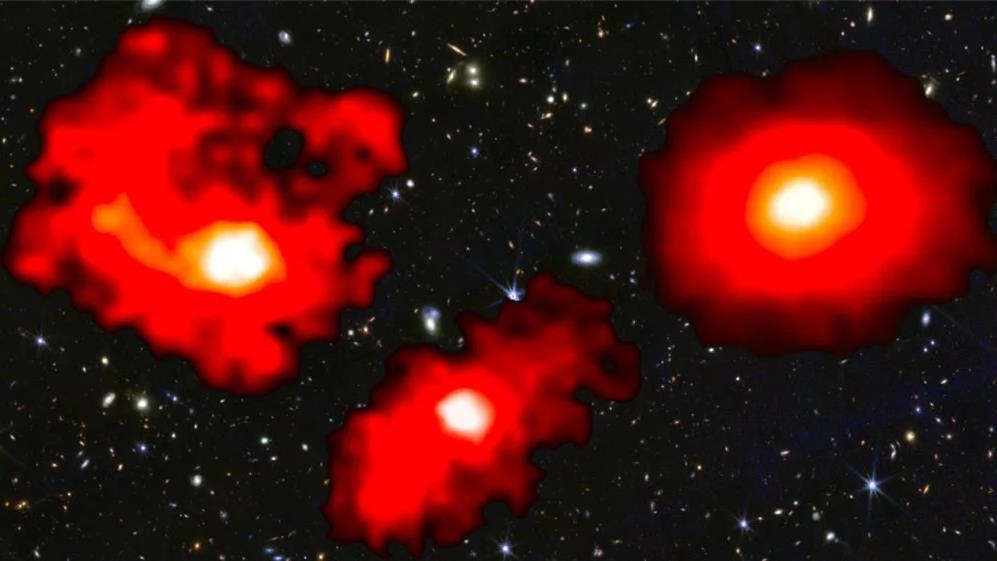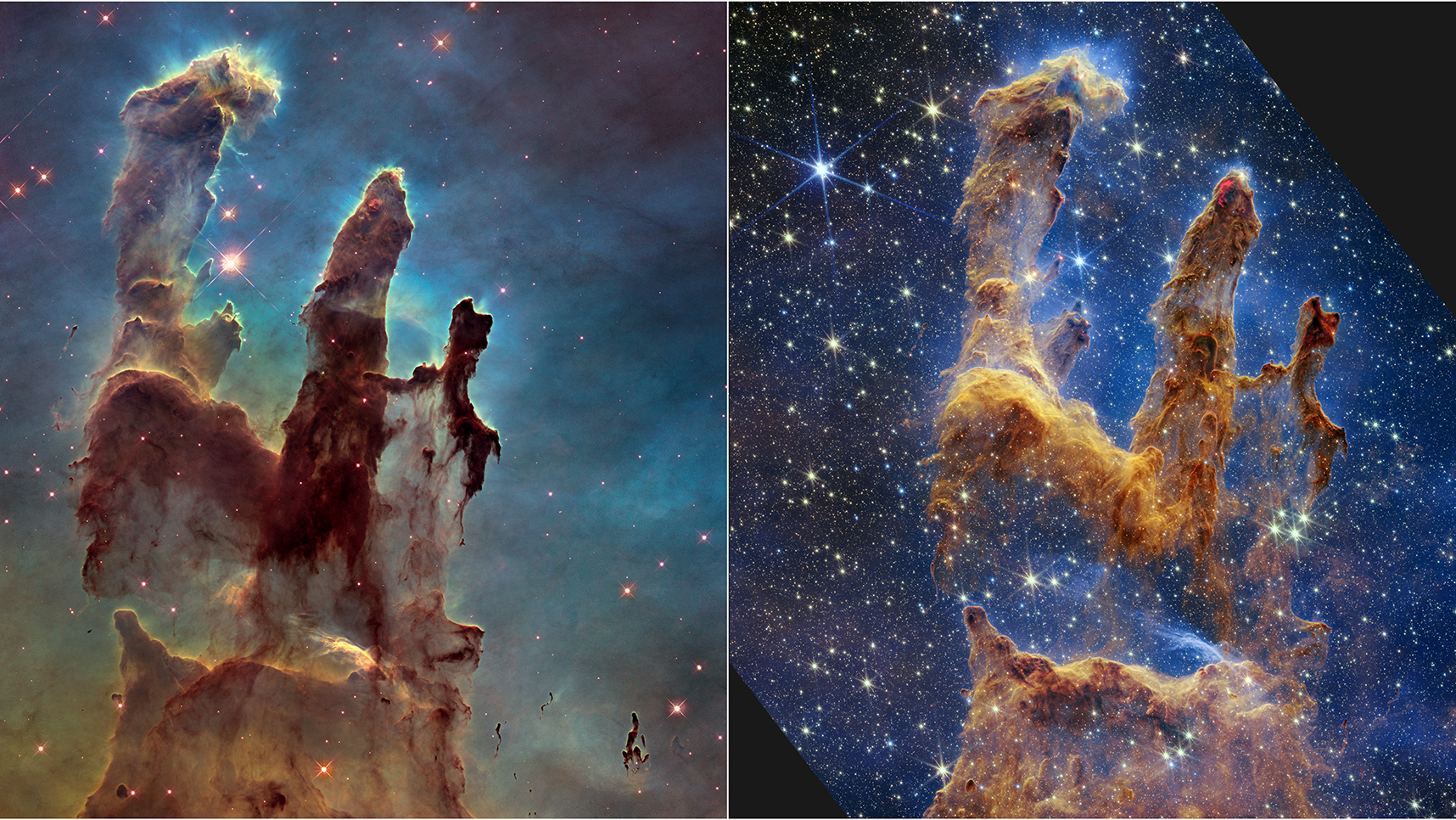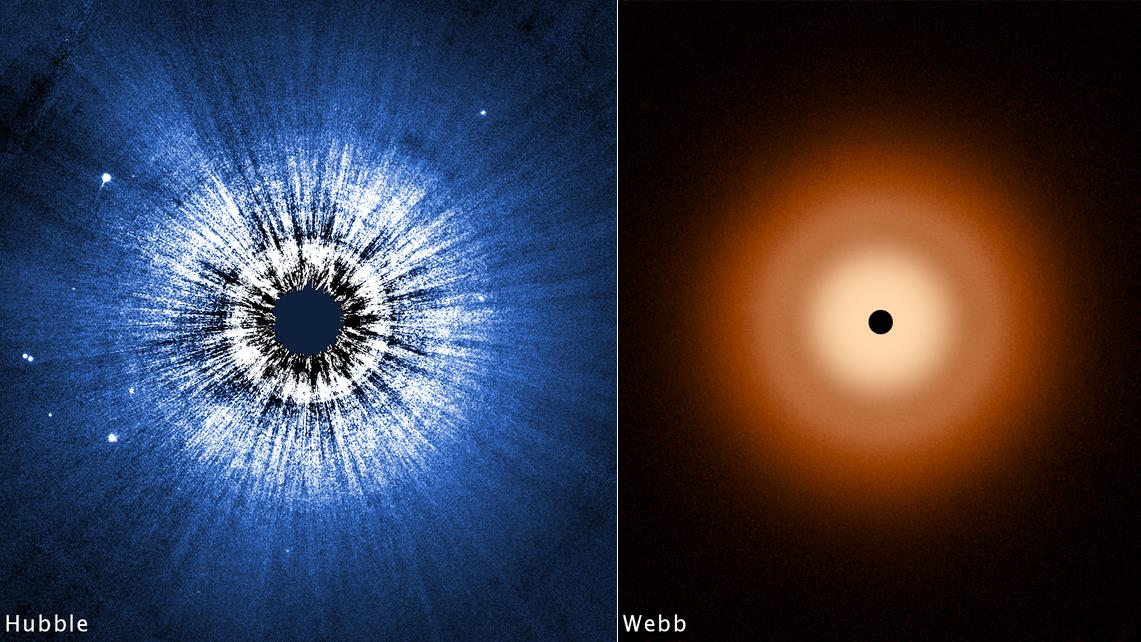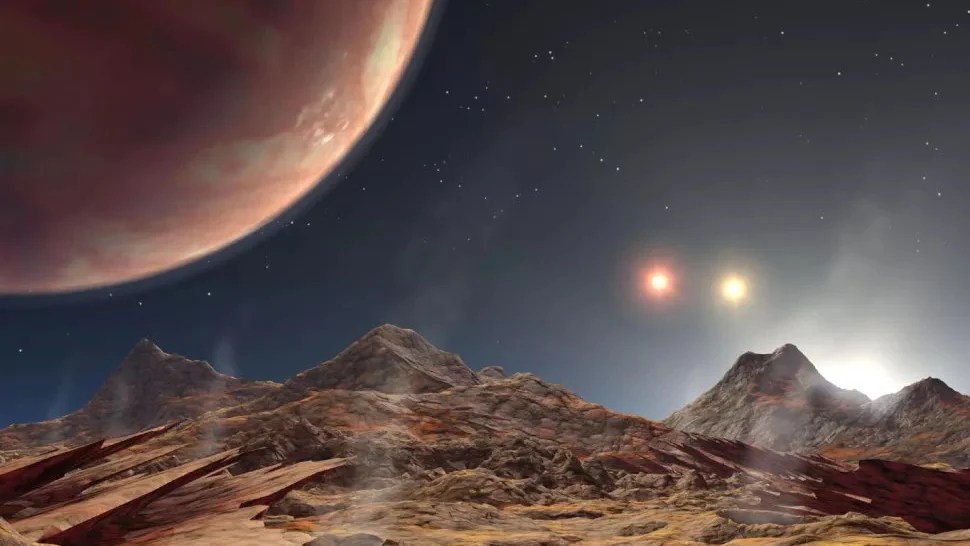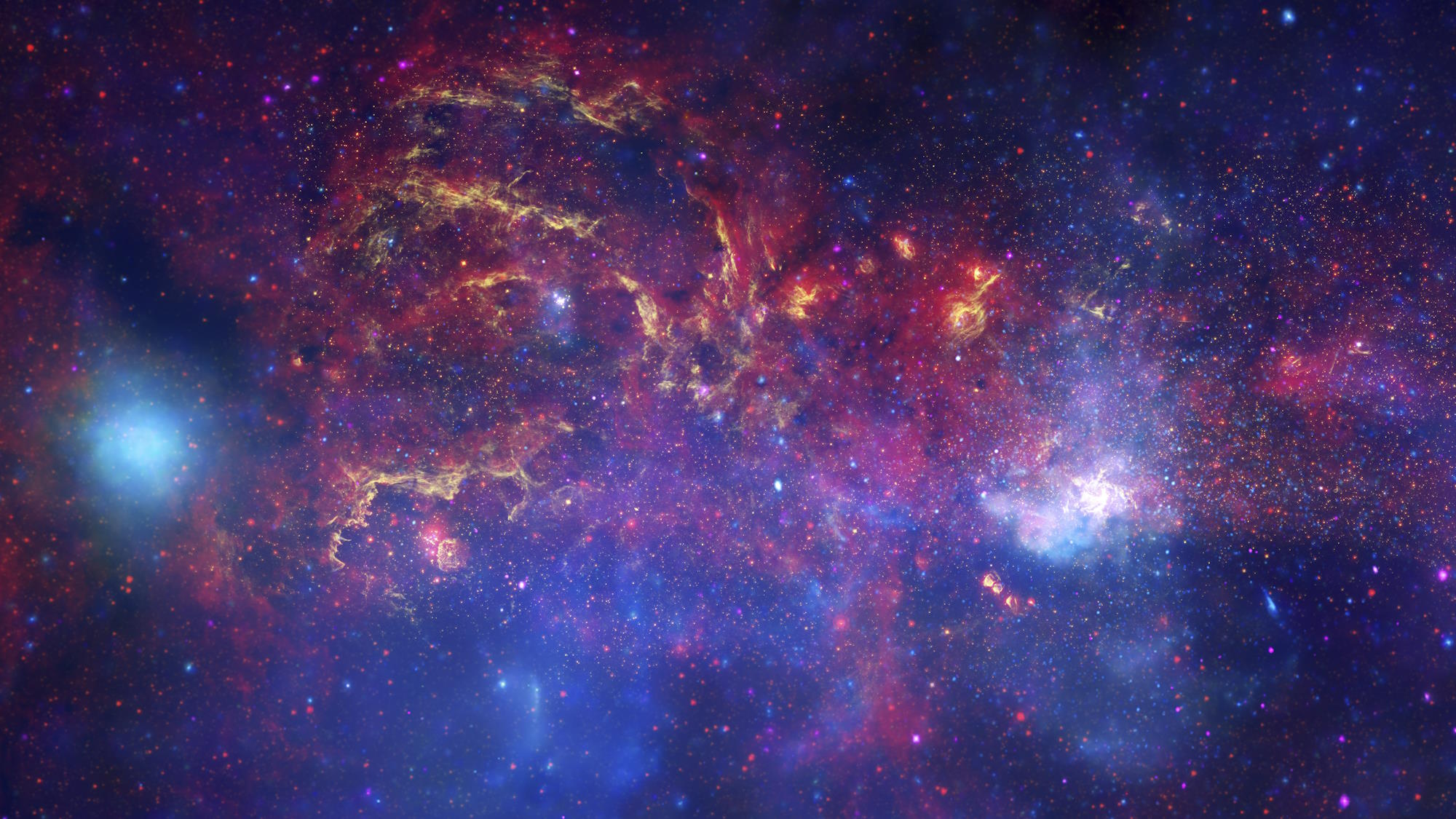Infinite Cosmos: The inside story behind JWST
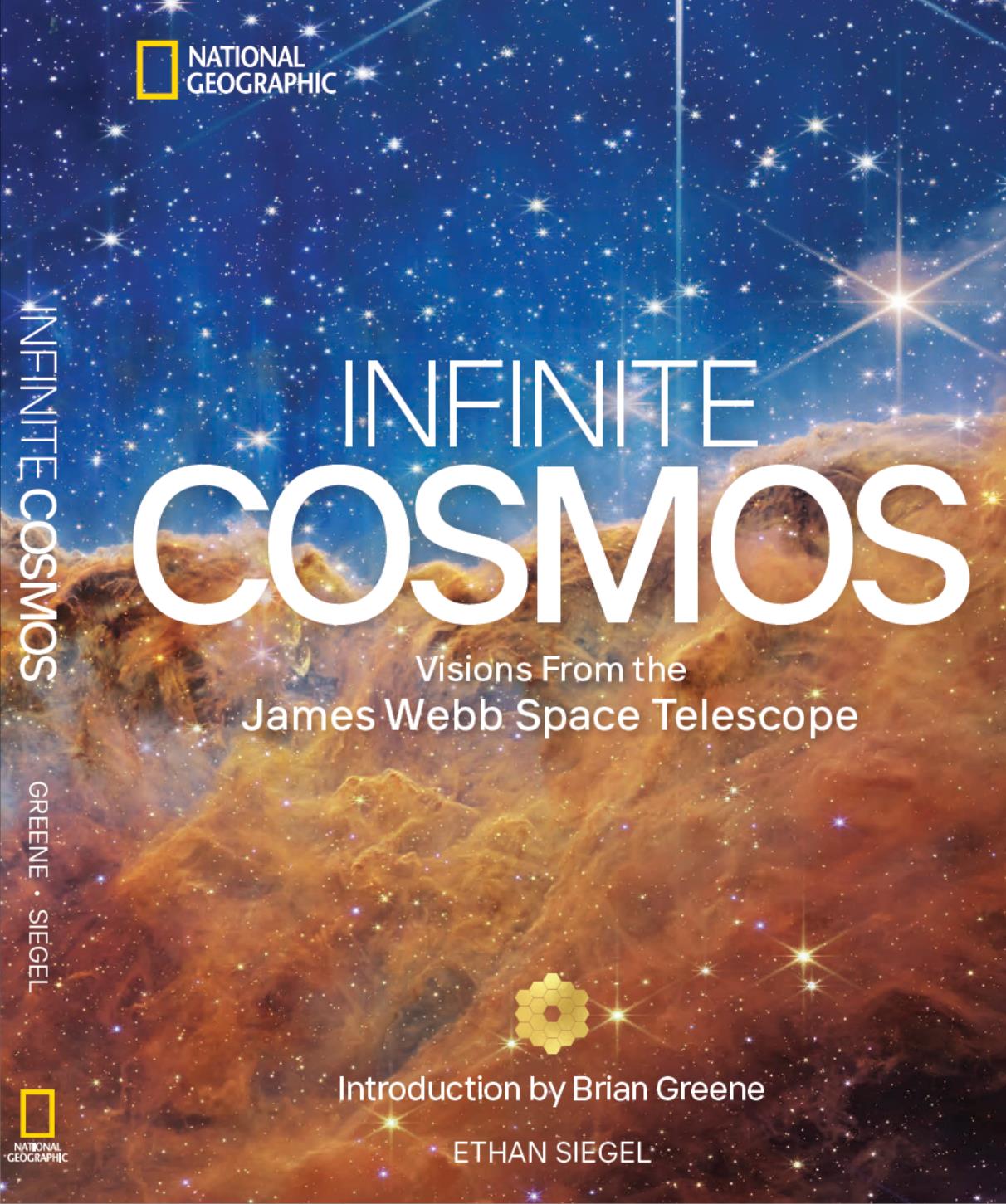
- Our understanding of the Universe changed forever on July 11, 2022, when the first science image from the James Webb Space Telescope (JWST) was revealed to humanity.
- Those first results were the culmination of years of planning, construction, and testing, all leading to a December 25, 2021 launch, followed by 6+ months of deployment and careful calibration.
- In the 2+ years since, JWST’s views have reshaped our understanding of how the Universe grew up, from planetary systems to star-formation to the most distant galaxies and galaxy clusters of all.
- Here to highlight all of these aspects is a new book, Infinite Cosmos: Visions from the James Webb Space Telescope. It’s National Geographic’s first JWST book, and it’s an absolute masterpiece.
The James Webb Space Telescope (JWST) was one of the most ambitious projects ever undertaken by the scientific community. Seeking to see back farther in space and earlier in time than any other astronomical observatory in history required a novel design and a series of new technological innovations. These included:
- a folded, segmented mirror,
- an enormous, novel, 5-layered sunshield,
- an incredibly smooth primary mirrored surface (with imperfections no greater than 20 nanometers), designed to operate in the cold, gravity-free environment of deep space,
- four instruments optimized for JWST’s infrared capabilities,
and so much more. After years of design, construction, and repeated testing, JWST was finally deemed “launch-ready” and shipped across international waters to the spaceport in French Guiana.
On December 25, 2021, a near-perfect launch ensued, sending JWST on a one-way journey to the L2 Lagrange point on the opposite side of Earth from the Sun: 1.5 million kilometers away. Over the ensuing months, JWST was deployed, collected its first light, and saw the entire observatory calibrated in a series of steps to make it “science-ready.” Then, on July 11, 2022, its first science image was released: the first of thousands that have not only pushed back the frontiers of what we know about how the Universe grew up but have surprised us in a number of important and fascinating ways.
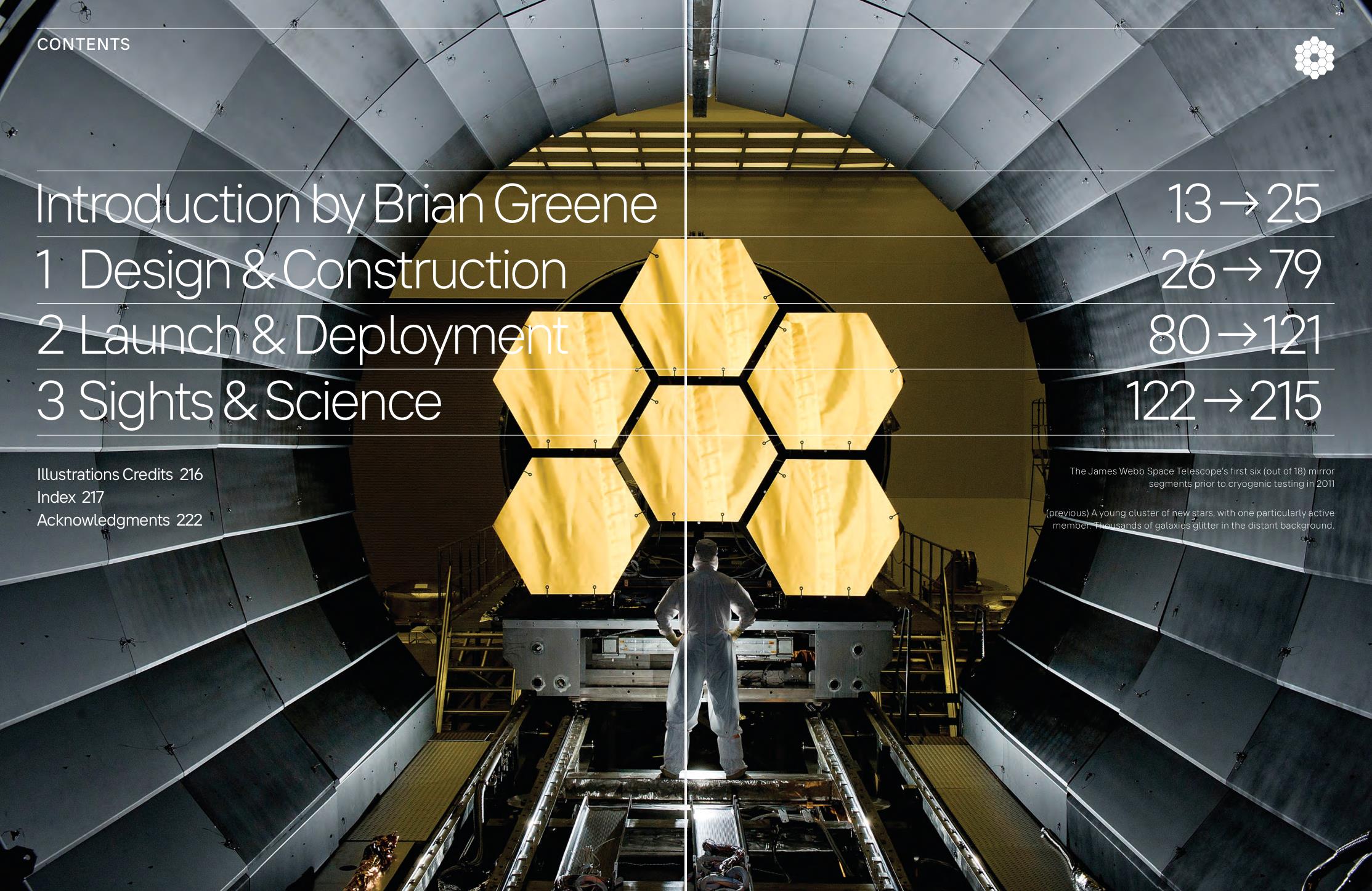
In Infinite Cosmos: Visions from the James Webb Space Telescope, humanity’s newest flagship space observatory finally gets the National Geographic treatment. Inside, you can read about the story of JWST’s:
- design and construction,
- launch and deployment,
- and the sights and science that it has brought to us,
all after a remarkable introduction by the one and only Brian Greene. Exquisitely designed, with custom illustrations and state-of-the art imagery from JWST and NASA, the book also contains explainer text, detail-rich image captions, and eight separate “Focus on” sections that go in-depth into one particular aspect of JWST.
The following is an excerpt from Infinite Cosmos: Visions from the James Webb Space Telescope, by National Geographic Books, authored by Ethan Siegel with an introduction by Brian Greene. It showcases the content of pp. 166-183, which is part of the book’s Chapter 3: “Sights and Science.”

Planet-forming surprises
Since the Hubble era, we’ve seen that newly forming stars typically are surrounded by disks of matter: regions where planets, moons, and smaller bodies form. These protoplanetary disks, or proplyds, are likely responsible for the majority of planets that form in the universe, including, some 4.5 billion years ago, the planets in our own solar system.
But with JWST, we’re seeing new features within these disks, providing information that showcases the many ways in which solar systems form. Data from JWST is uncovering how water arrives on the rocky planets that take shape within these disks: via ice pebbles that migrate inward. JWST is measuring the presence and abundance of various molecules and chemical compounds—including benzene and other organic molecules—that are found at various distances from a newly formed planet’s central star, providing new details that inform our understanding of how planets form. It’s unveiling more about debris disks, some of which persist for hundreds of millions of years, well after planets finish forming, and how they originate and are replenished through cosmic collisions.
Perhaps most spectacularly, around the nearby young star Fomalhaut, JWST observations have revealed three dusty areas:
- an inner disk, whose edge corresponds to our solar system’s asteroid belt;
- an outer, extended ring, corresponding to our own Kuiper belt; and
- a mysterious, unexpected intermediate belt, with no known analogue.
For a long time, we assumed our own solar system would serve as a prototypical template for other stellar and planetary systems. With JWST’s observations, we’ve already learned that our cosmic backyard is not the only option, and indeed that it may not even be a typical example of what’s out there in the universe.
These surprises, found in young planetary systems, are merely the first hints of all the new knowledge that will continue to arrive throughout the JWST era.
A stellar surprise
This image shows the young, nearby star Fomalhaut, one of the 20 brightest stars in Earth’s night sky, as observed with JWST’s coronagraphic capabilities. A coronagraph is a special instrument that blocks the light from the main star, allowing astronomers to measure faint details around them: in this case, a dusty debris disk. Around the star, JWST data confirmed three independent regions: an inner disk, corresponding to our asteroid belt and inner planets; an outer belt, corresponding to our Kuiper belt; and an intermediate belt, newly discovered, with no analogue within our solar system. Is this configuration common? New discoveries often lead to unexpected, deeper questions.
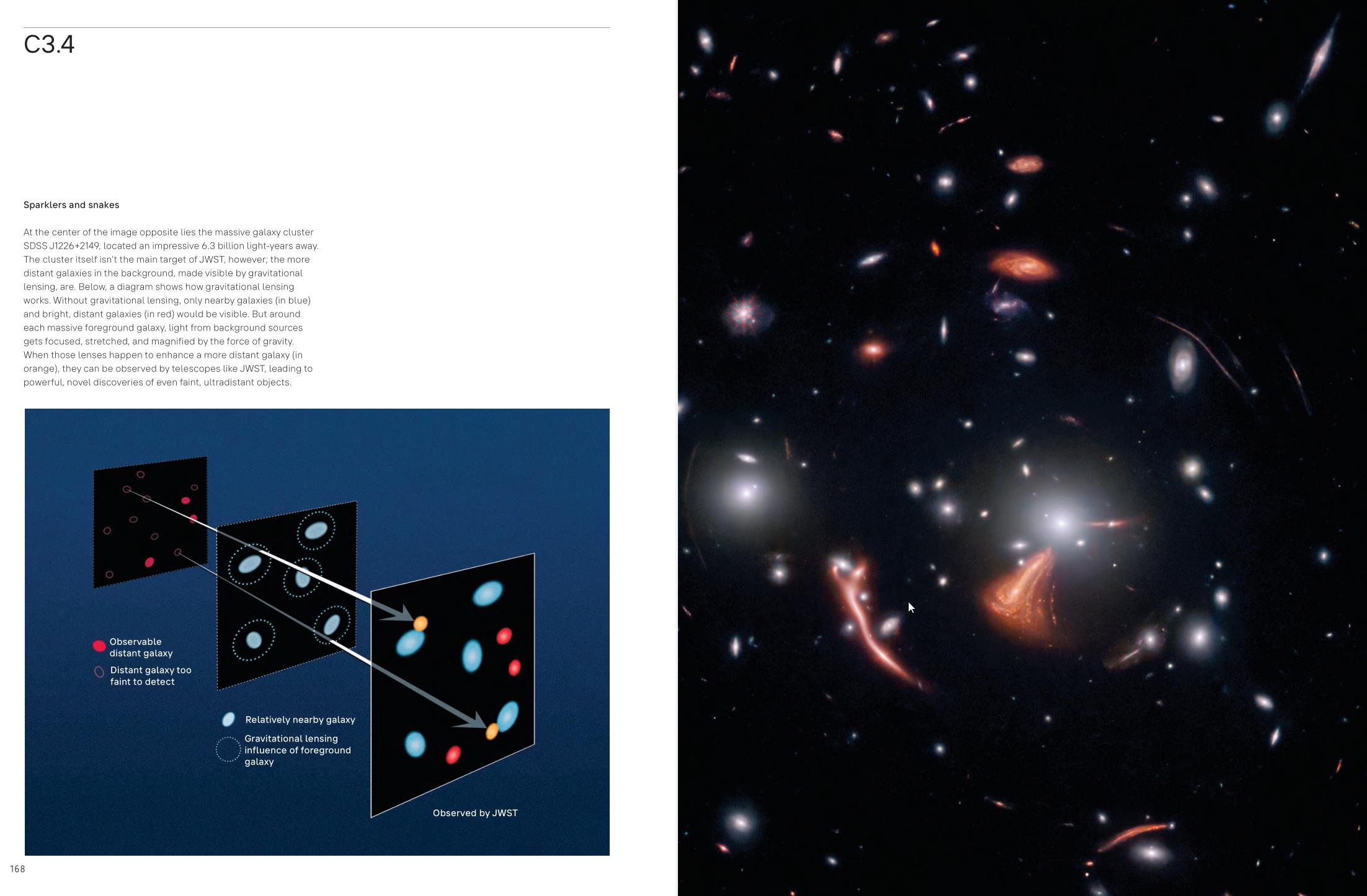
Sparklers and snakes
At the center of the image above lies the massive galaxy cluster SDSS J1226+2149, located an impressive 6.3 billion light-years away. The cluster itself isn’t the main target of JWST, however; the more distant galaxies in the background, made visible by gravitational lensing, are. Below, a diagram shows how gravitational lensing works. Without gravitational lensing, only nearby galaxies (in blue) and bright, distant galaxies (in red) would be visible. But around each massive foreground galaxy, light from background sources gets focused, stretched, and magnified by the force of gravity. When those lenses happen to enhance a more distant galaxy (in orange), they can be observed by telescopes like JWST, leading to powerful, novel discoveries of even faint, ultradistant objects.

Eye of the storm
This isn’t a ghostly view of a hurricane, but rather the heart of a nearby spiral galaxy discovered way back in 1780: the Phantom Galaxy, M74. Seen with MIRI, the dust distribution within the galaxy is mapped out, heavily lining its spiral arms. Great apparent holes in the dust correspond to regions where new stars have recently formed, with their ultraviolet light carving deep cavities as the dust evaporates nearby. In the center of the galaxy, a lack of gas allows JWST to capture an exquisite view of the stars clustered deep inside.
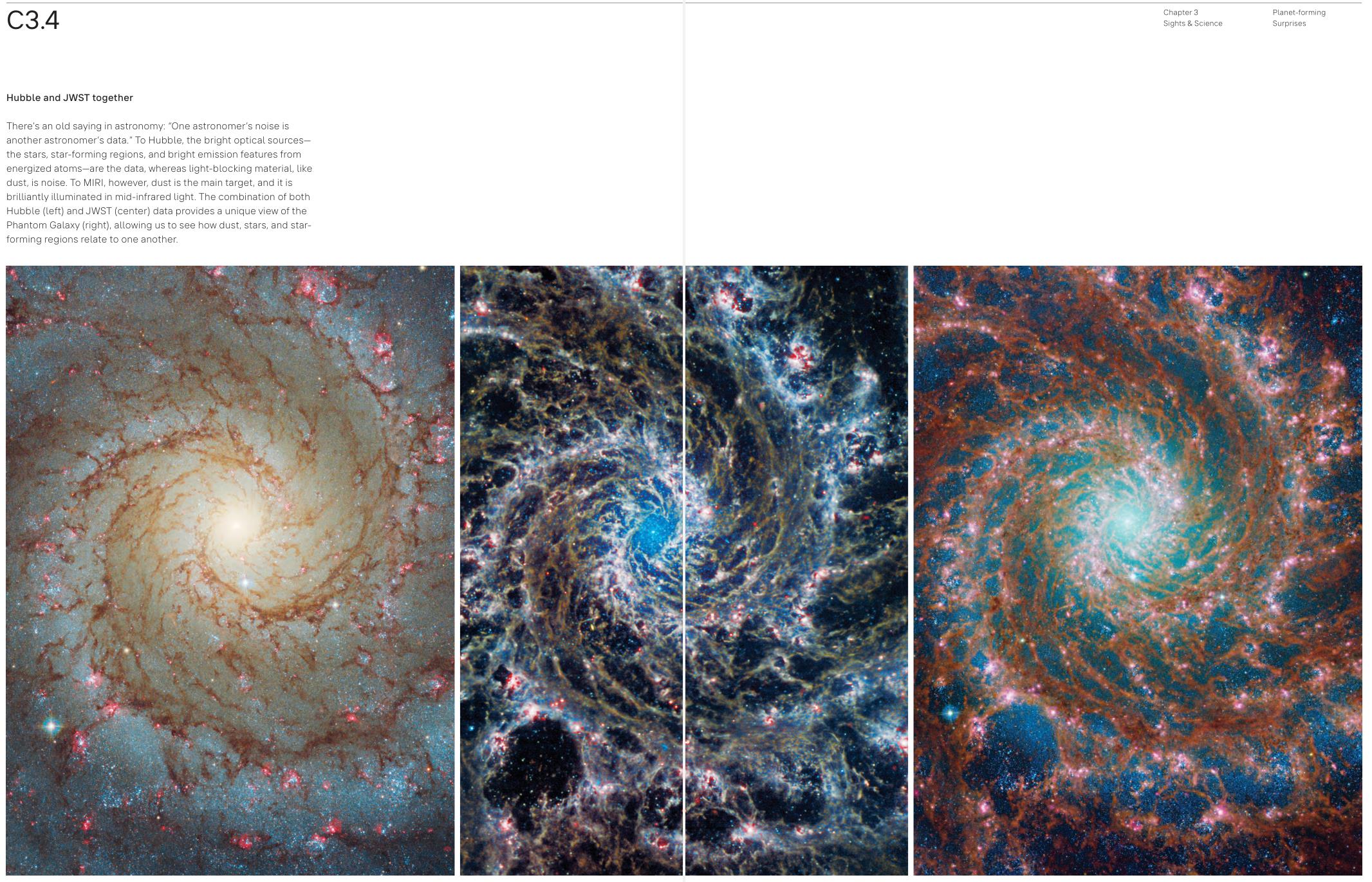
Hubble and JWST together
There’s an old saying in astronomy: “One astronomer’s noise is another astronomer’s data.” To Hubble, the bright optical sources—the stars, star-forming regions, and bright emission features from energized atoms—are the data, whereas light-blocking material, like dust, is noise. To MIRI, however, dust is the main target, and it is brilliantly illuminated in mid-infrared light. The combination of both Hubble (left) and JWST (center) data provides a unique view of the Phantom Galaxy (right), allowing us to see how dust, stars, and star-forming regions relate to one another.
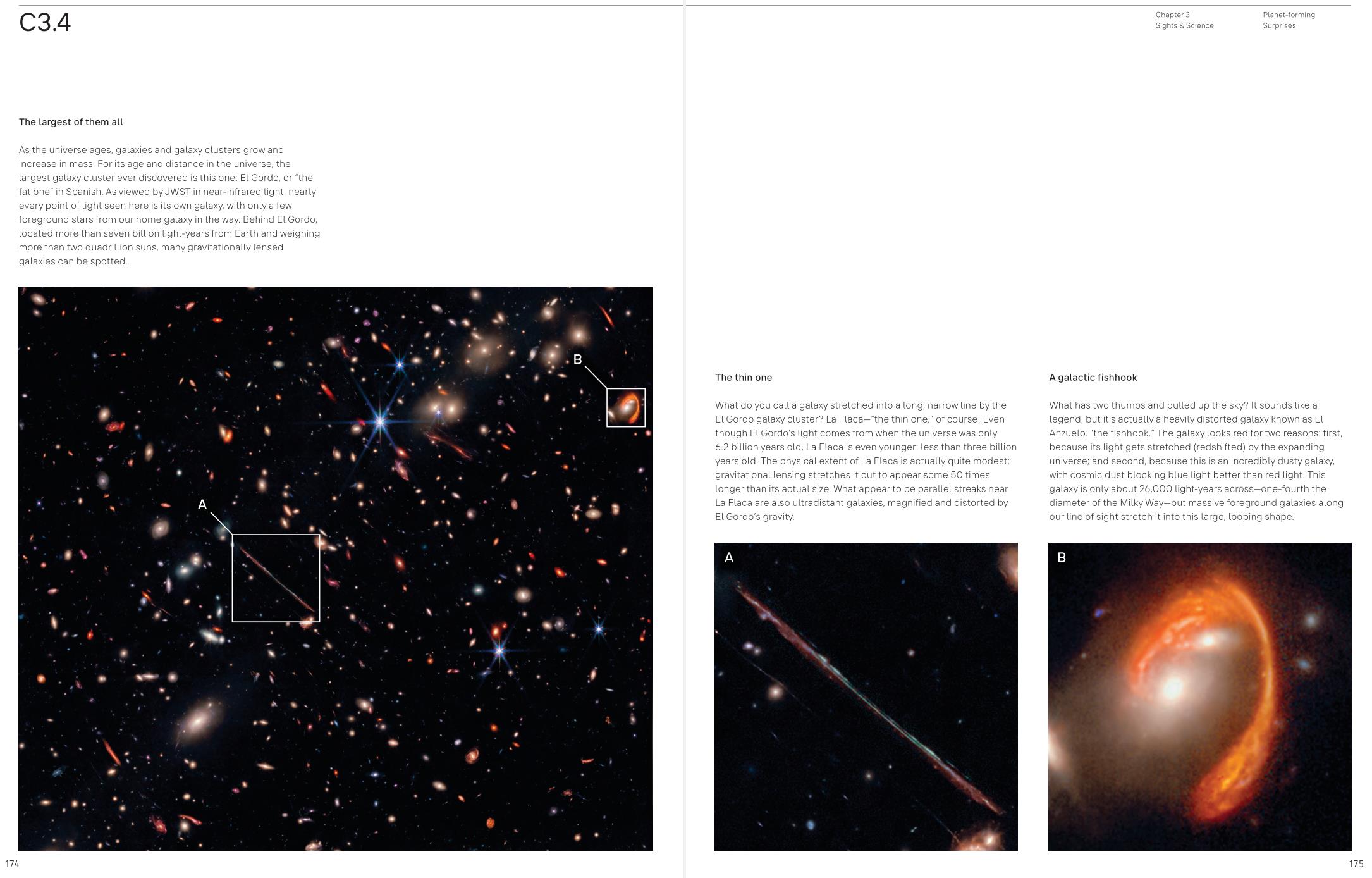
The largest of them all
As the universe ages, galaxies and galaxy clusters grow and increase in mass. For its age and distance in the universe, the largest galaxy cluster ever discovered is this one: El Gordo, or “the fat one” in Spanish. As viewed by JWST in near-infrared light, nearly every point of light seen here is its own galaxy, with only a few foreground stars from our home galaxy in the way. Behind El Gordo, located more than seven billion light-years from Earth and weighing more than two quadrillion suns, many gravitationally lensed galaxies can be spotted.
The thin one
What do you call a galaxy stretched into a long, narrow line by the El Gordo galaxy cluster? La Flaca “the thin one,” of course! Even though El Gordo’s light comes from when the universe was only 6.2 billion years old, La Flaca is even younger: less than three billion years old. The physical extent of La Flaca is actually quite modest; gravitational lensing stretches it out to appear some 50 times longer than its actual size. What appear to be parallel streaks near La Flaca are also ultradistant galaxies, magnified and distorted by El Gordo’s gravity.
A galactic fishhook
What has two thumbs and pulled up the sky? It sounds like a legend, but it’s actually a heavily distorted galaxy known as El Anzuelo, “the fishhook.” The galaxy looks red for two reasons: first, because its light gets stretched (redshifted) by the expanding universe, and second, because this is an incredibly dusty galaxy, with cosmic dust blocking blue light better than red light. This galaxy is only about 26,000 light-years across—one-fourth the diameter of the Milky Way—but massive foreground galaxies along our line of sight stretch it into this large, looping shape.

A dying star, filtered
Human eyes typically possess only three types of color receptors, or cones, and so only three separate filters are needed to create a full-color image for our perception. But JWST has more than 20 filters between MIRI and NIRCam. The choice of which filter(s) to highlight can dramatically change what our eyes perceive. In this image of the Southern Ring, the cool gas expelled by the dying star is highlighted, emphasizing the dying star (in red) and its brighter, still living companion (in blue) alongside it.
Same star, different filter
This combined MIRI and NIRCam view highlights what different filters of light see when they observe the same object. Instead of showing the cold gas in a shell around the dying star, this view highlights the knotted ejecta, showcasing the emptiness of the cavity as well as concentric streams of gas blown off in prior centuries and millennia. The spoke-like features accentuate where light streams through holes within the gaseous nebula.
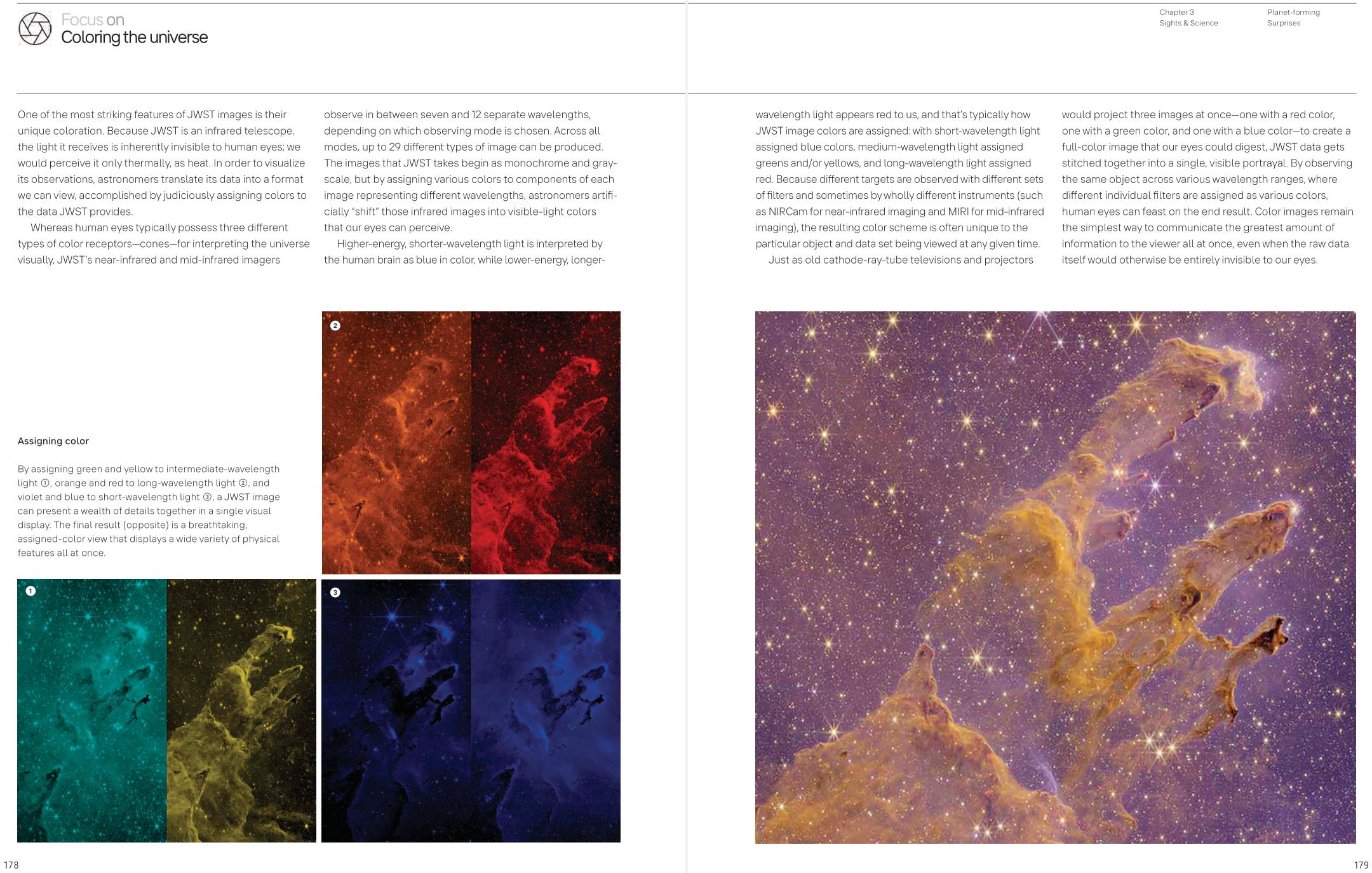
Coloring the universe
One of the most striking features of JWST images is their unique coloration. Because JWST is an infrared telescope, the light it receives is inherently invisible to human eyes; we would perceive it only thermally, as heat. In order to visualize its observations, astronomers translate its data into a format we can view, accomplished by judiciously assigning colors to the data JWST provides.
Whereas human eyes typically possess three different types of color receptors—cones—for interpreting the universe visually, JWST’s near-infrared and mid-infrared imagers observe in between seven and 12 separate wavelengths, depending on which observing mode is chosen. Across all modes, up to 29 different types of image can be produced. The images that JWST takes begin as monochrome and gray-scale, but by assigning various colors to components of each image representing different wavelengths, astronomers artificially “shift” those infrared images into visible-light colors that our eyes can perceive.
Higher-energy, shorter-wavelength light is interpreted by the human brain as blue in color, while lower-energy, longer-wavelength light appears red to us, and that’s typically how JWST image colors are assigned: with short-wavelength light assigned blue colors, medium-wavelength light assigned greens and/or yellows, and long-wavelength light assigned red. Because different targets are observed with different sets of filters and sometimes by wholly different instruments (such as NIRCam for near-infrared imaging and MIRI for mid-infrared imaging), the resulting color scheme is often unique to the particular object and data set being viewed at any given time.
Just as old cathode-ray-tube televisions and projectors would project three images at once—one with a red color, one with a green color, and one with a blue color—to create a full-color image that our eyes could digest, JWST data gets stitched together into a single, visible portrayal. By observing the same object across various wavelength ranges, where different individual filters are assigned as various colors, human eyes can feast on the end result. Color images remain the simplest way to communicate the greatest amount of information to the viewer all at once, even when the raw data itself would otherwise be entirely invisible to our eyes.
Assigning color
By assigning green and yellow to intermediate-wavelength light ①, orange and red to long-wavelength light ②, and violet and blue to short-wavelength light ③, a JWST image can present a wealth of details together in a single visual display. The final result is a breathtaking, assigned-color view that displays a wide variety of physical features all at once.

Gravitational lensing
Even with its unprecedented capabilities, JWST’s views of the universe are still finite and limited. The faintest, most distant objects in the cosmos—including the very first stars of all—remain invisible even in the longest-exposure JWST images acquired to date. The universe itself offers a natural enhancement, however, that can reveal features that would otherwise remain unobservable: gravitational lensing.
Whenever a large amount of mass gathers together in one location, it bends and distorts the fabric of the surrounding space-time, just as the theory of general relativity dictates. As light from background objects even farther away passes close to or through that region of the universe, it not only gets distorted but also gets magnified and potentially bent, either into multiple images or into a complete or partial ring. The foreground mass behaves as a gravitational lens. The amount of mass and how it’s distributed affect the light passing through it, amplifying the light coming from those background sources.
Gravitational lensing has brought a tremendous set of brilliant features into JWST’s view, including
- the most distant single star ever viewed, Earendel;
- a triply imaged supernova in a galaxy 16 billion light-years away;
- star formation occurring in distant globular clusters; and
- the tiniest early galaxy ever discovered, forming stars just 500 million years after the big bang.
With such an enhancement, thanks to gravity, extraordinarily distant objects have a chance of being captured by JWST’s eyes.
Better together
When both JWST and Hubble take a look at the same object—in this case, a small region within the galaxy cluster MACS 0416—the combined data present a spectacular array of features and colors. Here, while the yellowish galaxies are members of the cluster, located about 4.3 billion light-years away, the background galaxies are stretched into extreme, slender arcs via gravitational lensing. The bluest galaxies are actively forming stars and are best seen by Hubble in visible light, while the reddest galaxies are full of dust and best revealed by JWST’s infrared eyes.

Cosmic Chamaeleon
At about 500 light-years away, Chamaeleon I is one of the nearest star-forming regions. It was previously called a dark molecular cloud because of how effectively it blocks visible light. But now, thanks to JWST’s infrared-sensitive NIRCam, the cold, wispy material is lit up by the glow of the young protostar in the upper portion of this image. Four prominent foreground stars, in front of the nebula, exhibit brilliant diffraction spikes, while all other stars are much farther away, behind the nebula itself.
Full disclosure: This piece is written by Ethan Siegel, author of Infinite Cosmos. This book releases on October 8, 2024, and is available direct from Disney, Amazon, Barnes & Noble, and booksellers everywhere.
